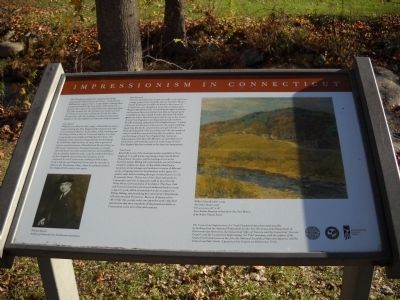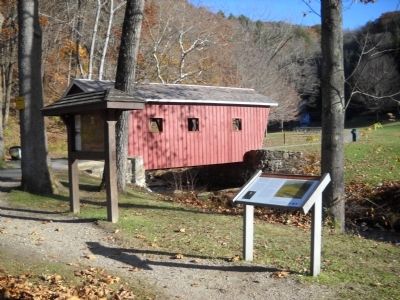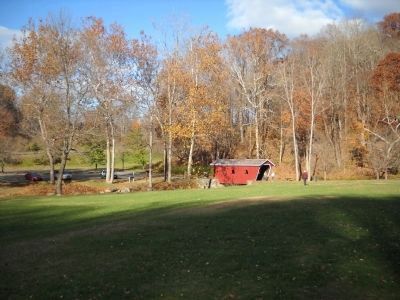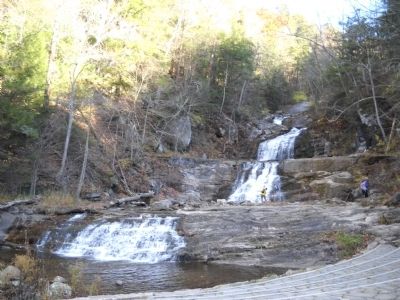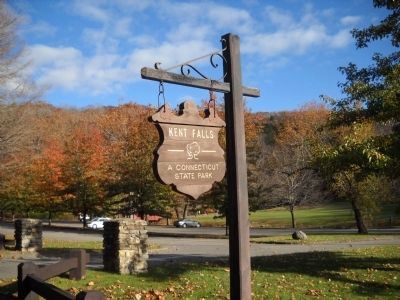Cornwall Bridge in Kent in Litchfield County, Connecticut — The American Northeast (New England)
Impressionism in Connecticut
This viewpoint extends the museum sites of the Connecticut Impressionist Art Trail – Connecticut’s Millennium Legacy Trail – to the outdoor settings that artists portrayed at the turn of the 20th century in a manner that came to be called American Impressionism. Visit the website for Connecticut Impressionist Art Trail to learn more about the Trail, the other Viewpoints, and the leading role that Connecticut played in the development of American Impressionism.
The Artist
Willard Leroy Metcalf (1858-1925), a Massachusetts native, began painting the New England hills when he was still an art student in Boston. In the 1880s, while studying and traveling in France, then in Tunis and Algeria, he came to appreciate natural light and high-keyed colors, two hallmarks of the American Impressionist art movement he would later help develop. In 1905, after a period of intense experimentation, Metcalf joined the art colony at Old Lyme, Connecticut. His impressionistic yet closely observed work won wide acclaim that year and established him as a leading American artist. Later he worked elsewhere in New England and traveled abroad again, but he continued to visit Connecticut, working at Old Lyme, Leete’s Island, and Waterford. From 1910 he was also at times in the Housatonic Valley, where he painted southern New England hill country once again.
The Painting
The view from this spot, despite its smaller scale and closer vantage point, looks much like that in November Mosaic. Similar landscapes are still to be found in this corner of Connecticut, even though it is more than a century since Willard Metcalf was here. Overlooking the signs of industry and business that were evident even then and ignoring the waterfalls and other natural wonders that attracted earlier American artists, Metcalf painted what he saw as the essence of rural New England: a sparkling stream, lush meadow, friendly mountain, and prosaic New England homes. Tucked as they are into the heart of his picture, the simple buildings imply that the hardy, unpretentious people who live in them are in harmony with one another and with the sunstruck natural world that surrounds them like an embrace. Such was the image of rural New England that American Impressionists like Metcalf offered in an unsettled era of urbanization and urbanity, and such is the image of rural New England that has endured in the American imagination.
The Place
Kent Falls is one of the most spectacular waterfalls in New England. It would not be surprising to learn that Willard Metcalf knew this place and had indulged here in his favorite pastime, fishing with artist friends, several of whom visited or settled near Kent. At Kent Falls State Park a mountain stream plunges and tumbles in a series of falls and pools, dropping some two hundred feet in the space of a quarter mile, before winding through a hemlock grove to the Housatonic River. This is one of the oldest state parks in Connecticut and was in large part a gift in 1915 from the White Memorial Foundation of Litchfield. The State Park and Forest Commission purchased additional land to create a 295-acre park, which is maintained today as a place for hiking, fishing, and picnicking by Connecticut’s Department of Environmental Protection. Because of preservation efforts like this, people today can enjoy the same unspoiled natural sites that drew hundreds of Impressionist artists to Connecticut at the turn of the 20th century.
Topics. This historical marker is listed in this topic list: Arts, Letters, Music. A significant historical year for this entry is 1905.
Location. 41° 46.599′ N, 73° 25.003′ W. Marker is in Kent, Connecticut, in Litchfield County. It is in Cornwall Bridge. Marker is on Kent Cornwall Road (U.S. 7), on the right when traveling north. Marker is located in Kent Falls State Park. Touch for map. Marker is in this post office area: Kent CT 06757, United States of America. Touch for directions.
Other nearby markers. At least 8 other markers are within 5 miles of this marker, measured as the crow flies. Kent Falls State Park (here, next to this marker); Camp Macedonia Company 1191 (a few steps from this marker);
Seven Hearths (approx. 3.2 miles away); Kent (approx. 3.2 miles away); Francis L. Sheane Memorial (approx. 3.9 miles away); Warren (approx. 4.2 miles away); Warren Veterans Memorial (approx. 4.3 miles away); Kent Soldiers' Monument (approx. 4.8 miles away). Touch for a list and map of all markers in Kent.
More about this marker. The upper right of the marker features one of Metcalf’s paintings. It has a caption of “Willard Metcalf (1858-1925) November Mosaic, 1922 Oil on canvas, 26” x 28” New Britain Museum of American Art, New Britain; John Butler Talcott Fund.”
The bottom left contains a photograph of Willard Metcalf, from the Archives of American Art, Smithsonian Institution.
Credits. This page was last revised on February 10, 2023. It was originally submitted on August 31, 2011, by Bill Coughlin of Woodland Park, New Jersey. This page has been viewed 722 times since then and 13 times this year. Photos: 1, 2, 3, 4, 5. submitted on August 31, 2011, by Bill Coughlin of Woodland Park, New Jersey.
